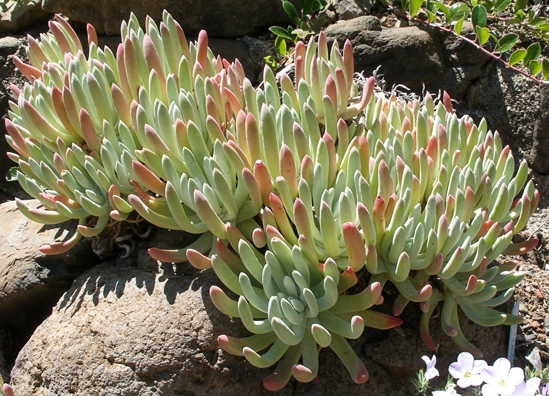
Like most succulents, Dudleyas have fleshy, swollen foliage that stores water. Another key trait is their farinose coating, which is made up of loose wax particles that come off when rubbed, giving many Dudleya species a blue-gray tinge. Do not try to remove this coating, as it provides UV protection. When seen on fruits such as blueberries or plums, this wax is known as a “bloom.”
Dudleyas come in two forms: branching and unbranching. Branching dudleyas tend to form spreading colonies and are best used as ground covers in the garden. Unbranching types form large rosettes and are great as focal points. Both kinds like containers and have a long life span, living 50-100 years, given the right conditions. They are perfect for rock retaining wall crevices, as this is how they naturally grow.
The species listed below are frost tolerant but need afternoon shade in the San Joaquin Valley heat:
Branching
Coast dudleya(Dudleya caespitosa): 4”-6” high, spreading (not invasive)
Liveforever (Dudleya cymosa): 6”, spreading (not invasive); hardiest to heat and cold of the species listed here
Unbranching
Cliff lettuce (Dudleya farinosa): 12” rosette
Chalk liveforever (Dudleya pulverulenta): 12” – 24” rosette with a thick, farinose coating.
Cultural requirements
Although most succulents require little irrigation, many come from desert climates where there is a winter and summer “wet” season. Unlike the desert succulents you typically find in nurseries, native Dudleyas evolved in our summer-dry Mediterranean climate, and often lack resistance to pathogens associated with summer moisture. This is is why Dudleyas are best combined with other plants that also dislike summer irrigation, such as Coyote mint (Monardella villosa), St. Catherine's lace (Eriogonum giganteum), Purple needlegrass (Stipa pulchra), or Chaparral currant (Ribes malvaceum).
Dudleyas are easy to care for, given the right conditions. Flower stalks can be removed when bloom is over. Either wait until they are dry enough to pull away easily or cut with pruning shears to avoid accidentally uprooting the entire plant. Resist removing all of the old, dry leaves, as these help stabilize larger single-rosette types (a long, exposed stem is easy to knock over).
Soggy soil can be a problem for Dudleyas, so provide good drainage and plant so that they are tilted sideways, allowing water to run off. If planted in clay soil, avoid watering in the summer; in sandy soils, some summer water is OK. They will naturally die back at the end of summer without irrigation, often turing red as the foliage desiccates, before regenerating when fall and winter rains begin. Avoid trying to circumvent this natural cycle with extra irrigation, as it may shorten their life span by increasing their susceptibility to root rots. You can also prevent root rots and fungus problems by mulching with gravel and avoiding organic materials such as bark.
If you have a gardening related question you can contact the UC Master Gardeners at 209-953-6112. More information can be found on our website.